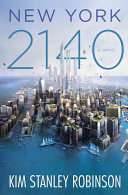New York 2140
 | |
| Author | Kim Stanley Robinson |
|---|---|
| Country | United States |
| Language | English |
| Genre | Science fiction |
| Publisher | Orbit |
Publication date | 2017 |
| Media type | Print (Hardback & Paperback) |
| Pages | 624 pages |
| ISBN | 978-0-316-26234-7 |
New York 2140 is a 2017 climate fiction novel by American science fiction author Kim Stanley Robinson. The novel is set in a New York City that has been flooded and altered by rising water. The novel received generally positive reviews.
Setting
The novel is mostly set in New York City, which has been flooded by two major rises in seawater levels caused by climate change.[1] All of the boroughs, with the exception of Manhattan, are permanently underwater. Much of Manhattan below 46th Street is also flooded, and has earned the nickname "SuperVenice". The wealthy live in newly constructed skyscrapers in uptown Manhattan and near The Cloisters. Denver has replaced New York as the center of American finance and culture, and much of the United States has been deliberately abandoned by humans in order to make room for wildlife. Robinson has addressed sea level rise in the background of his works Aurora and the Mars trilogy.[2]
Several of the book's characters live in the MetLife Tower. Robinson chose the building as it was designed to resemble the St Mark's Campanile in Venice.[3]
Scientific accuracy
The book is set in a New York City suffering from a 50-foot rise in seawater. However, scientists suggest a rise between 3 and 15 feet is more likely by 2140, not a 50-foot one.[4][5] Such a rise would likely mean some flooding in portions of Manhattan, Brooklyn, and Queens, but not on the same scale as featured in the novel.[5] Robinson has referred to the sea-level rise in the book as "extreme".[3]
Themes
The novel is critical of capitalism, unregulated financial systems, and market economies.[6] Many of the citizens of the city live in communes and rely on organizations that pool resources, while the wealthy live in former office buildings and newly-built skyscrapers above 125th Street and in Yonkers.
Reception
Critics gave the novel mostly positive reviews, according to the literary criticism aggregator Literary Hub.[7] Gerry Canavan, writing for the Los Angeles Review of Books, referred to the novel as a further step in Robinson's "construction of a huge metatextual history of the future... distributed across overlapping but distinct and mutually irreconcilable texts".[2]
References
- ↑ Valentine, Genevieve (19 March 2017). "In '2140,' New York May Be Underwater, But It's Still Home". NPR. Retrieved 5 May 2017.
- 1 2 Canavan, Gerry (11 March 2017). "Utopia in the Time of Trump". Los Angeles Review of Books. Retrieved 12 September 2017.
- 1 2 Swearingen, Jake (27 March 2017). "Kim Stanley Robinson's New York 2140: To Save the City, We Had to Drown It". NYMag. Retrieved 5 May 2017.
- ↑ Kopp, Robert (12 March 2017). "New York 2140: A novelist's vision of a drowned city that still never sleeps". Salon. Retrieved 5 May 2017.
- 1 2 Rutkoff, Aaron (8 March 2017). "Only Sci-Fi Can Drown Manhattan and Make You Want to Live There". Bloomberg. Retrieved 5 May 2017.
- ↑ Rothman, Joshua (27 April 2017). "Kim Stanley Robinson's Latest Novel Imagines Life in an Underwater New York". The New Yorker. Retrieved 5 May 2017.
- ↑ "New York 2140". Literary Hub. 14 March 2017. Retrieved 12 September 2017.